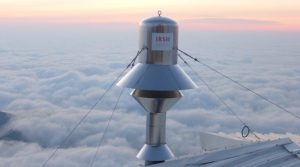Weekly high-volume sampling of atmospheric radionuclides
About 150,000 m3 of air (equivalent to about 114,000 Nm3 at 15°C and 1000 hPa) and 13,500 m3 (12,000 Nm3) are filtered weekly at Pic du Midi and CRA, respectively. Aerosol filters are analyzed by gamma spectrometry at trace-level environmental radioactivity laboratories of the French Institute for Nuclear Safety and Radiation Protection (IRSN) in the context of its national monitoring network “Opera” (https://www.irsn.fr/recherche/reseau-opera-air). This network comprises about 50 aerosol sampling stations of which a dozen can sample large volume (> 100,000 m3 per sample). To date, the Pic du Midi high-volume sampler is the most performing aerosol sampling equipment in France whatever the purpose of sampling. The combination of high-volume sampling and trace-level determination makes it possible to determine minute concentrations of artificial radionuclides (as well as more abundant naturally occurring radionuclides) and to detect any unusual or unexpected radionuclides in the atmosphere. At the Pic du Midi, large filters are used (44 cm X 56 cm) to cope with the high flow rate of the pump (900 m3/h). Both filters at Pic du Midi and CRA are made of polypropylene fibbers.
Data for 21 natural and artificial radionuclides are available since 2014 and 2018 for CRA and Pic du Midi, respectively, at https://www.mesure-radioactivite.fr/#/expert (research keys in “commune” (city) field: CAMPISTROUS for CRA and BAGNERES-DE-BIGORRE for PDM)

